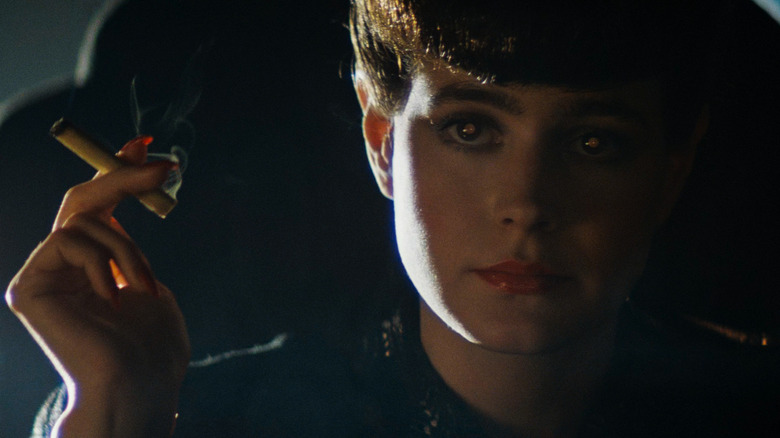Blade Runner Had A Brilliantly Simple Solution For Putting The Shine In Replicants' Eyes
2019 has come and gone, and it didn't look much like the flying-car future envisioned by Ridley Scott's "Blade Runner" in 1982. However, as the movie turns 40, it remains a sci-fi classic that continues to find new fans and influence new generations of filmmakers, such as Christopher Nolan, who drew inspiration from it for "Batman Begins" and who has his own hot take about what the best version of "Blade Runner" is.
What's all the more impressive about "Blade Runner" in retrospect is it came well before the advent of digital effects in Hollywood. In this respect, "Blade Runner 2049" director Denis Villeneuve had a major advantage over Scott when he was mounting his 2017 sequel. Yet despite all odds, back in '82, Scott and his crew were still able to conjure an evocative, rain-drenched, neon-lit vision of a futuristic Los Angeles using practical techniques. It simply required a little creative problem-solving on the part of crew members like special photographic effects supervisor Douglas Trumbull.
In a 2017 interview with Wired to promote the release of "Blade Runner 2049," Scott recalled one particular challenge on the original "Blade Runner" where Trumbull's innovation came in handy. He said:
"I'm making the film at a time when 'digital' doesn't even have a word. I said, 'How the hell do I differentiate between a replicant?' I need to have light in their eyes, in the way that the leopard's eyes in [Stanley Kubrick's '2001: A Space Odyssey.'] And I said, 'How the hell do I do that?' I want it there occasionally so it's not insistent, it becomes too robotic. Every now and again I want a glint. So [Douglas Trumbull] said, 'Let me think about it.' This is typical Doug, who came up with a simple half mirror."
Lights and mirrors
Getting the glint to appear in a replicant's eye, as it does at one point with Rachael (Sean Young) while she is smoking a cigarette in "Blade Runner," involved angling a small light into a mirror off-camera. Scott explained:
"You have a sheet of glass which is half mirror, and the mirror is mounted on the camera in front of the lens at a 45-degree angle. And on one side, just behind the camera, is what in those days we'd call a pup, a very small light which is on a dimmer. You just turn it up with the subject sitting here, looking straight into the camera, you turn up this light, which is reflecting from the mirror, into the lens, but has not been photographed in the camera. And when she moved you got golden light on it from the retina. Genius."
The periodic glints that appear in the eyes of Rachael, Roy Batty (the late Rutger Hauer), and even a replicant owl in the Tyrell Corporation are small yet memorable details that add to the overall mood and milieu of "Blade Runner." It would be all too easy now for digital effects to, well, replicate the same glint in post-production. But Scott, Trumbull, and company had to improvise using the resources available to them, and they showed it was possible to do such a thing without the use of computers.
Just remember, if you see someone on the street with a glint in their eye, chances are, they're a replicant — or maybe there's a hidden camera somewhere.
